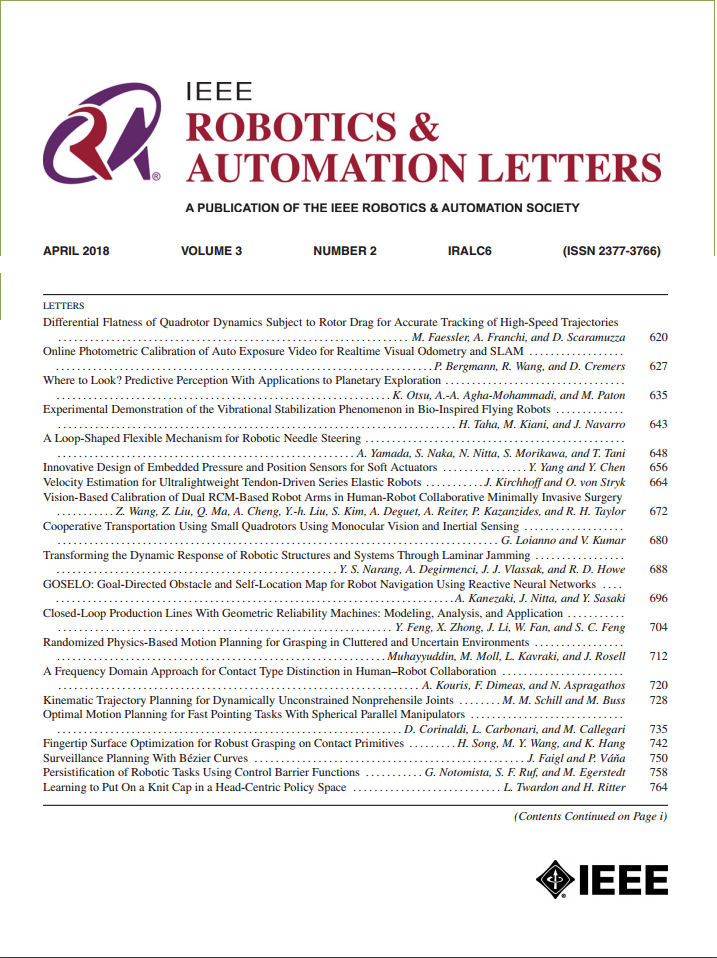增强磁性软执行器的致动性:一种结合内部磁耦合的逆设计框架
IF 5.3
2区 计算机科学
Q2 ROBOTICS
引用次数: 0
摘要
本文研究了磁性软执行器中内部磁相互作用的作用,并为其设计和优化引入了一种新的框架。磁性软致动器由嵌入磁性颗粒的软复合材料组成,可以在外部磁场下实现不受约束的变形和致动,在微创手术和干预等机器人应用中具有很大的潜力。现有的设计方法主要解决外场效应和机械阻力,往往忽略了内部磁相互作用的贡献,这是执行器性能的关键。为了解决这一差距,我们开发了一种集成了材料特性、致动器几何形状和内部磁动力学的逆设计方法。通过分析颗粒体积分数、磁矩强度以及饱和磁化强度和矫顽力等固有特性之间的相互作用,我们提出内部磁耦合可以显著增强变形。采用旋转方形磁元结构来评估驱动行为,比较有无内部耦合的性能。我们的研究结果表明,将内部磁相互作用纳入设计过程可以导致变形增加36-49%。此外,逆设计框架准确预测了执行器的性能,实验测量的松弛状态和驱动状态变形与仿真结果匹配在10%以内。本研究为该领域做出了贡献:1)量化了内部磁相互作用在提高致动器性能中的作用;2)开发了一种制造工艺,可以可靠地生产具有目标剩磁和杨氏模量的磁性软复合材料;3)引入了预测致动器设计的优化框架。本文章由计算机程序翻译,如有差异,请以英文原文为准。
Enhancing Actuation in Magnetic Soft Actuators: An Inverse Design Framework Incorporating Internal Magnetic Coupling
This letter investigates the role of internal magnetic interactions in magnetic soft actuators and introduces a novel framework for their design and optimization. Magnetic soft actuators, composed of soft composites embedded with magnetic particles, enable untethered deformation and actuation under external magnetic fields and hold great potential for robotic applications such as minimally invasive surgery and intervention. Existing design approaches primarily address external field effects and mechanical resistance, often neglecting the contributions of internal magnetic interactions, which are critical to actuator performance. To address this gap, we develop an inverse design methodology that integrates material properties, actuator geometry, and internal magnetic dynamics. By analyzing the interplay between particle volumetric fractions, magnetic moment strengths, and intrinsic properties such as saturation magnetization and coercivity, we propose that internal magnetic coupling can significantly enhance deformation. Rotating-square magnetic metastructures are employed to evaluate actuation behaviors, comparing performance with and without internal coupling. Our findings demonstrate that incorporating internal magnetic interactions into the design process can lead to up to a 36–49% increase in deformation. In addition, the inverse design framework accurately predicted actuator performance, with experimental measurements of relaxed and actuated state deformations matching simulation results within 10%. This study contributes to the field by 1) quantifying the role of internal magnetic interactions in enhancing actuator performance, 2) developing a fabrication process that reliably produces a magnetic soft composite with targeted remanence and Young's modulus, and 3) introducing an optimization framework for predictive actuator design.
求助全文
通过发布文献求助,成功后即可免费获取论文全文。
去求助
来源期刊

IEEE Robotics and Automation Letters
Computer Science-Computer Science Applications
CiteScore
9.60
自引率
15.40%
发文量
1428
期刊介绍:
The scope of this journal is to publish peer-reviewed articles that provide a timely and concise account of innovative research ideas and application results, reporting significant theoretical findings and application case studies in areas of robotics and automation.
 求助内容:
求助内容: 应助结果提醒方式:
应助结果提醒方式:


